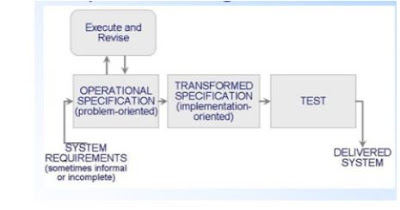SOFTWARE PROCESS MODELS:
1) WATERFALL MODEL:
- It's not flexible. Causes software failures. There is no iteration in waterfall model.
DRAWBACKS OF WF MODEL:
- No guidance on how to handle changes to products and activities during development.
- Views software development as manufacturing process rather than a creating process.
- There is no iterative activities that lead to creating a final product
- Long wait before a final product.
V MODEL:
If problems are found during verification and validation, the left side of the V can be re-executed before testing on the right side is rebuilt.
2) PROTOTYPING MODEL:
Allows repeated investigation of the requirements or design.
Reduces risk and uncertainty in the development.
3) OPERATIONAL SPECIFICATION MODEL:
- Requirements are executed and their implication evaluated early in the development process.
- Functionality and the design are allowed to be merged.
4) TRANSFORMATIONAL MODEL:
- Relies on formalism.
- Requires formal specification (to allow transformations)
- Fewer major development steps.
5) USIXML:
UsiXML is more than a XML-compliant markup language that describes the UI for multiple contexts of use such as Character User Interfaces (CUIs), Graphical User Interfaces (GUIs), Auditory User Interfaces, and Multimodal User Interfaces, it also considers models to support model-based User Interface development compliant with the cameleon reference framework.




No hay comentarios:
Publicar un comentario